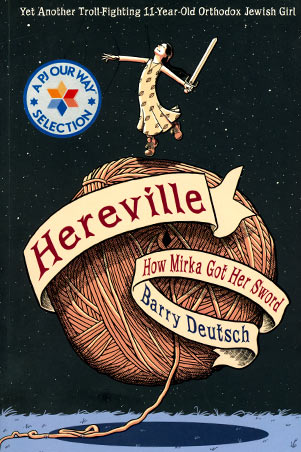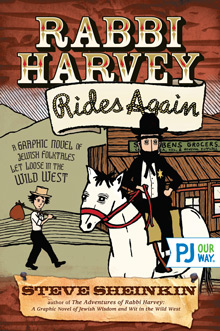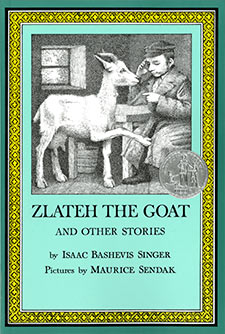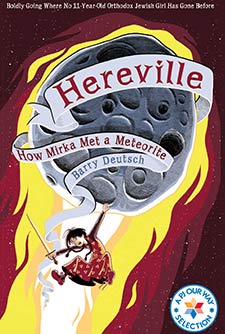Hereville: How Mirka Got Her Sword
Mirka the Dragon Slayer. Mirka the Brave. Mirka the Magnificent.
Mirka wants to slay dragons, but her stepmother wants her to … knit?
Mirka wants to slay dragons, but her stepmother wants her to … knit?
Average Rating
( hint: Login to leave a review! )
165 Reviews
Leave Review
What the Book is About
Jewish Content & Values
Positive Role Models
Content Advisory
Talk it Over!
More for You
What the Book is About
This offbeat graphic novel (a prequel to Hereville: Mirka and the Meteorite) is set in a fictitious Jewish shtetl called Hereville. The heroine, Mirka, is not your typical eleven year-old Orthodox Jewish shtetl girl. She despises knitting and dreams of fighting and slaying monsters ... although she’s not very good at it. When she’s offered an opportunity to win her very own sword, she discovers that having a clever plan is useful, especially if your opponent is stronger (and has better knitting skills!)
Jewish Content & Values
- Hereville is a fictional shtetl: full-color drawings depict girls and boys in traditional Orthodox garb from the shtetl era; boys and girls attend separate schools; and colorful Yiddish words that are translated in footnotes are used throughout.
- Mirka and her family celebrate Shabbos (Yiddish for Shabbat – the Jewish day of rest). Shabbos is an important spiritual time for Mirka who puts away her troll slaying ambitions and connects with her family.
- Tzar Baalei Chayim (suffering of living things) refers to the Jewish Talmudic principle that forbids causing unnecessary pain to animals. When Mirka sees bullies trying to hurt a pig, she intervenes to save him.
Positive Role Models
- Mirka is a fun character with lots of personality. Her impulsivity and passion often get her into trouble, but her good natured and introspective side cares deeply about doing the right thing.
- Fruma, Mirka’s stepmother, uses clever parenting techniques to educate all of her children and step children about how to become moral and responsible adults. She encourages them to work out math equations based on Shabbat guests and she introduces them to a broader world view by debating both sides of an issue.
Content Advisory
There’s some light comic book-style violence (i.e. Smack, Bam, Pow, Ouch) when Mirka and her brother face off against some bullies. There are also a few insults like “stupid” and “little creep,” as well as some colloquial and colorful Yiddish terms that could offend. Emotional content related to the death of Mirka’s mother years before might leave some kids feeling sad.
Talk it Over!
Mirka fights off bullies to protect Zindel, her little brother. Later, Mirka fights with Zindel when he tries to prevent her from getting the sword. Do you sometimes get along better with your siblings outside of the house? Why do you think that is?
More for You
In Hereville, Mirka doesn’t even recognize the pig because it’s not a kosher animal. Kosher and non-kosher animals are determined by a combination of their physical characteristics and Jewish tradition. Any animal that lives on land must have split hooves and chew its cud to be kosher. Fish and sea animals are only kosher if they have both fins and scales. Fowl are generally kosher unless they are predatory. And all reptiles, amphibians, worms, and insects are not kosher (aside from a few species of locusts, which are kosher by tradition).
What the Book is About
What the Book is About
This offbeat graphic novel (a prequel to Hereville: Mirka and the Meteorite) is set in a fictitious Jewish shtetl called Hereville. The heroine, Mirka, is not your typical eleven year-old Orthodox Jewish shtetl girl. She despises knitting and dreams of fighting and slaying monsters ... although she’s not very good at it. When she’s offered an opportunity to win her very own sword, she discovers that having a clever plan is useful, especially if your opponent is stronger (and has better knitting skills!)
Jewish Content & Values
Jewish Content & Values
- Hereville is a fictional shtetl: full-color drawings depict girls and boys in traditional Orthodox garb from the shtetl era; boys and girls attend separate schools; and colorful Yiddish words that are translated in footnotes are used throughout.
- Mirka and her family celebrate Shabbos (Yiddish for Shabbat – the Jewish day of rest). Shabbos is an important spiritual time for Mirka who puts away her troll slaying ambitions and connects with her family.
- Tzar Baalei Chayim (suffering of living things) refers to the Jewish Talmudic principle that forbids causing unnecessary pain to animals. When Mirka sees bullies trying to hurt a pig, she intervenes to save him.
Positive Role Models
Positive Role Models
- Mirka is a fun character with lots of personality. Her impulsivity and passion often get her into trouble, but her good natured and introspective side cares deeply about doing the right thing.
- Fruma, Mirka’s stepmother, uses clever parenting techniques to educate all of her children and step children about how to become moral and responsible adults. She encourages them to work out math equations based on Shabbat guests and she introduces them to a broader world view by debating both sides of an issue.
Content Advisory
Content Advisory
There’s some light comic book-style violence (i.e. Smack, Bam, Pow, Ouch) when Mirka and her brother face off against some bullies. There are also a few insults like “stupid” and “little creep,” as well as some colloquial and colorful Yiddish terms that could offend. Emotional content related to the death of Mirka’s mother years before might leave some kids feeling sad.
Talk it Over!
Talk it Over!
Mirka fights off bullies to protect Zindel, her little brother. Later, Mirka fights with Zindel when he tries to prevent her from getting the sword. Do you sometimes get along better with your siblings outside of the house? Why do you think that is?
More for You
More for You
In Hereville, Mirka doesn’t even recognize the pig because it’s not a kosher animal. Kosher and non-kosher animals are determined by a combination of their physical characteristics and Jewish tradition. Any animal that lives on land must have split hooves and chew its cud to be kosher. Fish and sea animals are only kosher if they have both fins and scales. Fowl are generally kosher unless they are predatory. And all reptiles, amphibians, worms, and insects are not kosher (aside from a few species of locusts, which are kosher by tradition).




